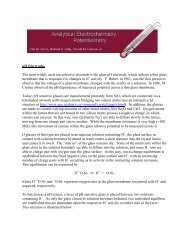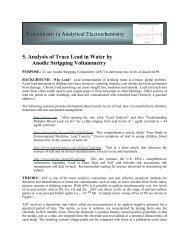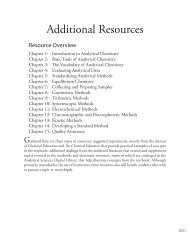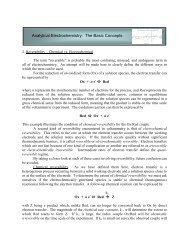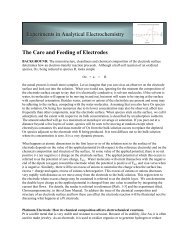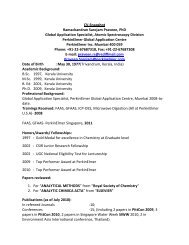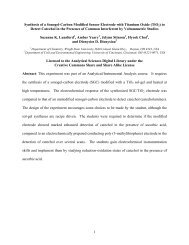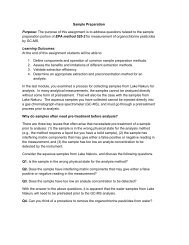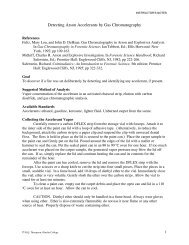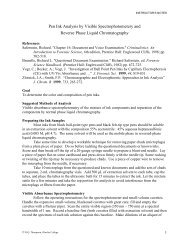Chapter 5 - Analytical Sciences Digital Library
Chapter 5 - Analytical Sciences Digital Library
Chapter 5 - Analytical Sciences Digital Library
Create successful ePaper yourself
Turn your PDF publications into a flip-book with our unique Google optimized e-Paper software.
154 <strong>Analytical</strong> Chemistry 2.0<br />
See <strong>Chapter</strong> 9 for a thorough discussion of<br />
titrimetric methods of analysis.<br />
The base NaOH is an example of a secondary<br />
standard. Commercially available<br />
NaOH contains impurities of NaCl,<br />
Na 2 CO 3 , and Na 2 SO 4 , and readily<br />
absorbs H 2 O from the atmosphere. To<br />
determine the concentration of NaOH in<br />
a solution, it is titrated against a primary<br />
standard weak acid, such as potassium hydrogen<br />
phthalate, KHC 8 H 4 O 4 .<br />
5A<br />
<strong>Analytical</strong> Standards<br />
To standardize an analytical method we use standards containing known<br />
amounts of analyte. The accuracy of a standardization, therefore, depends<br />
on the quality of the reagents and glassware used to prepare these standards.<br />
For example, in an acid–base titration the stoichiometry of the acid–base reaction<br />
defines the relationship between the moles of analyte and the moles<br />
of titrant. In turn, the moles of titrant is the product of the titrant’s concentration<br />
and the volume of titrant needed to reach the equivalence point.<br />
The accuracy of a titrimetric analysis, therefore, can be no better than the<br />
accuracy to which we know the titrant’s concentration.<br />
5A.1 Primary and Secondary Standards<br />
We divide analytical standards into two categories: primary standards and<br />
secondary standards. A primary standard is a reagent for which we can<br />
dispense an accurately known amount of analyte. For example, a 0.1250-g<br />
sample of K 2 Cr 2 O 7 contains 4.249 × 10 –4 moles of K 2 Cr 2 O 7 . If we place<br />
this sample in a 250-mL volumetric flask and dilute to volume, the concentration<br />
of the resulting solution is 1.700 × 10 –3 M. A primary standard<br />
must have a known stoichiometry, a known purity (or assay), and it must<br />
be stable during long-term storage. Because of the difficulty in establishing<br />
the degree of hydration, even after drying, a hydrated reagent usually is not<br />
a primary standard.<br />
Reagents that do not meet these criteria are secondary standards.<br />
The concentration of a secondary standard must be determined relative<br />
to a primary standard. Lists of acceptable primary standards are available. 2<br />
Appendix 8 provides examples of some common primary standards.<br />
5A.2 Other Reagents<br />
Preparing a standard often requires additional reagents that are not primary<br />
standards or secondary standards. Preparing a standard solution, for<br />
example, requires a suitable solvent, and additional reagents may be need<br />
to adjust the standard’s matrix. These solvents and reagents are potential<br />
sources of additional analyte, which, if not accounted for, produce a determinate<br />
error in the standardization. If available, reagent grade chemicals<br />
conforming to standards set by the American Chemical Society should be<br />
used. 3 The label on the bottle of a reagent grade chemical (Figure 5.1) lists<br />
either the limits for specific impurities, or provides an assay for the impurities.<br />
We can improve the quality of a reagent grade chemical by purifying it,<br />
or by conducting a more accurate assay. As discussed later in the chapter, we<br />
2 (a) Smith, B. W.; Parsons, M. L. J. Chem. Educ. 1973, 50, 679–681; (b) Moody, J. R.; Greenburg,<br />
P. R.; Pratt, K. W.; Rains, T. C. Anal. Chem. 1988, 60, 1203A–1218A.<br />
3 Committee on <strong>Analytical</strong> Reagents, Reagent Chemicals, 8th ed., American Chemical Society:<br />
Washington, D. C., 1993.



